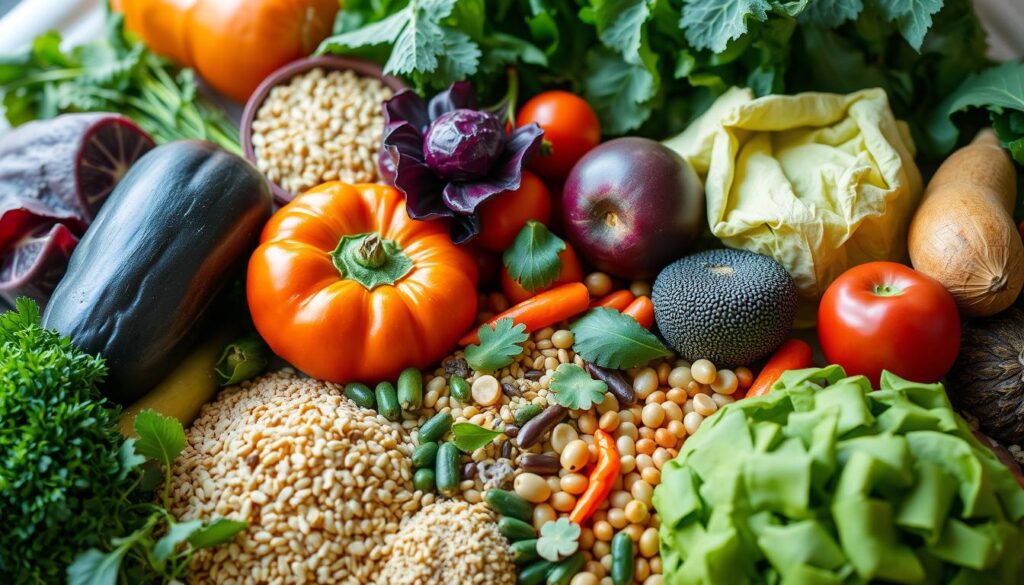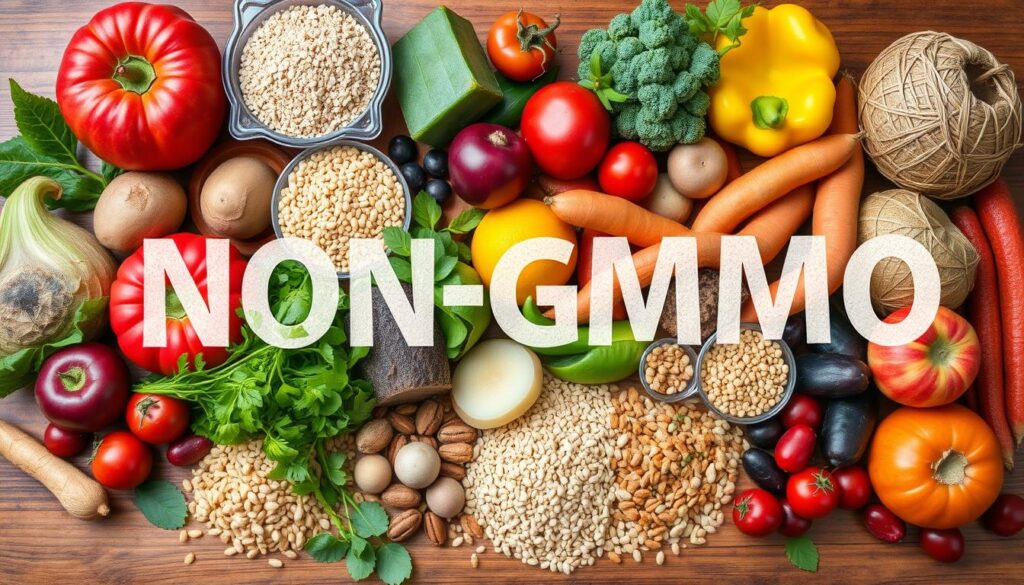Are you a health-conscious consumer looking to make informed decisions about the ingredients in your everyday products? Join us as we explore the world of non-GMO ingredients. In this guide, we’ll explain what non-GMO means, the science behind genetic modification, and its effects on health and the environment. Get ready to become a savvy shopper and make choices that reflect your values.
Key Takeaways
- Discover the definition of non-GMO ingredients and how they differ from genetically modified alternatives.
- Explore the science behind genetic modification and its potential impacts on human health and the environment.
- Understand the growing consumer demand for non-GMO products and the history of the non-GMO movement.
- Learn how to identify non-GMO ingredients in everyday products and navigate the various certification standards.
- Explore the benefits of choosing non-GMO ingredients and their connection to the clean label movement.
What Are Non-GMO Ingredients and Why They Matter
In today’s world, non-GMO ingredients are a big deal. But what are they, and why do people care? Let’s look into genetic modification and its effects on health and the planet.
The Science Behind Genetic Modification
Genetic modification changes an organism’s DNA to add new traits. It’s used in farming to make crops better, like pest-resistant or longer-lasting. But, the effects of GMOs on health and the environment are still up for debate.
Impact on Human Health and Environment
Some worry GMOs could harm human health. Research links GMOs to allergies, digestive problems, and diseases. Also, GMO crops’ pesticides harm bees and pollute nearby crops.
Consumer Awareness and Demand
As GMO risks become known, more people want non-GMO food. They look for organic produce, sustainable farming, and clear labels. This change pushes the food industry to offer more non-GMO choices and be open about what’s in their products.

Knowing about GMOs helps us make better food choices. Choosing non-GMO supports sustainable farming and a healthier future for all.
The History and Evolution of Non-GMO Ingredients
The story of non-GMO ingredients is both fascinating and complex. It spans from ancient farming to today’s food concerns. This journey highlights our growing interest in plant-based foods and knowing where our food comes from.
Long ago, our ancestors used selective breeding and traditional farming to grow their food. These methods, passed down through generations, helped create the wide variety of plant-based foods we enjoy today.
With the advent of genetic modification, a new era in food production began. But this change also raised concerns about health and the environment. This led to a rise in demand for non-GMO options.
Now, the non-GMO movement is stronger than ever. People are more aware of the need for food traceability and want to make better food choices. They look for products with non-GMO certification, showing a change in how we view our food.
The rise of non-GMO ingredients is a testament to our collective desire to reconnect with the natural world and rediscover the true essence of what nourishes us.
Looking back, the history of non-GMO ingredients reminds us of our deep connection to the earth. It shows our dedication to keeping our food supply safe and pure.

Common Non-GMO Ingredients in Everyday Products
As we aim for a cleaner, greener lifestyle, knowing what’s in our products is key. Let’s explore non-GMO ingredients. We’ll look at common grains, fruits, veggies, and sweeteners that are GMO-free.
Popular Non-GMO Grains and Cereals
- Whole wheat flour
- Oats
- Brown rice
- Quinoa
- Millet
These grains and cereals are the base of many tasty, healthy meals. They offer important nutrients, fiber, and carbs. This makes them essential in clean and eco-friendly products.
Non-GMO Fruits and Vegetables
- Apples
- Bananas
- Broccoli
- Carrots
- Spinach
Choosing non-GMO fruits and veggies means you get their natural goodness. They’re key to a healthy, sustainable diet.
Natural Sweeteners and Alternatives
- Honey
- Maple syrup
- Dates
- Stevia
- Agave nectar
Switching to natural sweeteners is a smart move. It lets you enjoy sweetness without the harm of refined sugars.
Learning about these non-GMO ingredients helps us make better choices. It supports a clean, eco-friendly lifestyle. Choosing natural products is a simple yet powerful step towards a healthier, greener future.
How to Identify Non-GMO Products While Shopping
We all want to make smart choices about the food we eat. Spotting non-GMO products in the grocery store is a big part of that. Here are some tips to help you find those non-GMO labels and seals of approval.
Transparency in Labeling
Start by checking the labels closely. Look for “Non-GMO” or “Non-GMO Project Verified” labels. These labels mean the product has been tested and is GMO-free.
Understanding Certifications
Also, watch for certifications from trusted groups. The Non-GMO Project is a top program that checks for GMOs. Other good ones are USDA Organic and Certified Organic. These all mean the product doesn’t have GMOs.
| Certification | Meaning |
|---|---|
| Non-GMO Project Verified | The product has been rigorously tested and certified to be free of genetically modified organisms. |
| USDA Organic | The product is made with organic ingredients and does not contain GMOs. |
| Certified Organic | The product is made with certified organic ingredients and prohibits the use of GMOs. |
By looking for these certifications, you know you’re choosing non-GMO products. This matches your health goals.
Transparency in labeling is key when it comes to identifying non-GMO products. Look for clear and prominent labels that give you the peace of mind you deserve.
Being a smart shopper helps you get products that fit your non-GMO needs. With these tips, you’ll easily spot non-GMO products in the store.
Understanding Non-GMO Certification Standards
Exploring non-GMO certifications can seem overwhelming. But knowing the key players and their methods is key for smart shopping. We’ll look at the main certification groups, their strict checks, and what those non-GMO labels mean.
Major Certification Bodies
Several top organizations lead in non-GMO certification. The Non-GMO Project, a leading non-profit, is known for its detailed verification. It ensures products meet high standards for food traceability and transparency in labeling. The USDA Organic seal also means a product is non-GMO, as it bans genetic engineering in organic farming.
Verification Process
- Thorough ingredient testing and supplier audits to verify non-GMO status
- Evaluation of manufacturing processes to prevent cross-contamination
- Regular on-site inspections and ongoing monitoring to maintain certification
Label Requirements
The non-GMO label on a product comes from a strict check. It shows the product has less than 0.9% genetically modified ingredients. This ensures high food traceability and transparency in labeling. Look for the Non-GMO Project Verified seal or the USDA Organic certification for sure non-GMO buys.
| Certification Body | Key Requirements | Label Appearance |
|---|---|---|
| Non-GMO Project | Less than 0.9% GMO ingredients, comprehensive traceability | |
| USDA Organic | Prohibition of genetic engineering, organic farming practices |
Choosing non-GMO products is about more than just avoiding genetically modified ingredients. It’s about supporting a food system that prioritizes transparency in labeling and food traceability.
Benefits of Choosing Non-GMO Ingredients
As health-conscious consumers, we seek informed choices that match our values. Choosing non-GMO food is a big step. It offers many benefits for our health and the planet.
Choosing non-GMO ingredients can improve our health. Organic and non-GMO foods are rich in nutrients and free from harmful chemicals. This reduces our exposure to pesticides and additives linked to health issues.
The non-GMO movement also helps the environment. Sustainable farming, used by non-GMO producers, keeps our soil, water, and ecosystem healthy. By choosing non-GMO, we help conserve natural resources and lower our carbon footprint.
| Benefits of Non-GMO Ingredients | Organic Produce | Sustainable Farming |
|---|---|---|
| Potential Health Benefits | ✓ | ✓ |
| Environmental Preservation | ✓ | ✓ |
| Support for Local Economies | ✓ | ✓ |
Choosing non-GMO ingredients also supports local economies and small farmers. We empower farmers who use sustainable methods and are transparent about their supply chains. This helps our local food systems thrive and strengthens our communities.
Opting for non-GMO ingredients makes a big difference. It aligns our food choices with our values. We nourish our bodies and contribute to a sustainable future. Let’s choose non-GMO and make choices that benefit our health, the environment, and our communities.
The food you eat can be either the safest and most powerful form of medicine or the slowest form of poison.” – Ann Wigmore
The Connection Between Organic and Non-GMO Ingredients
We often face a maze of choices when it comes to organic and non-GMO ingredients. These terms might seem similar, but they have their own unique aspects. Let’s explore how these two concepts relate to each other in the world of clean label and eco-friendly products.
Key Differences and Similarities
Organic and non-GMO are not the same, but they share some commonalities. Organic items are made without synthetic pesticides, fertilizers, or GMOs. Non-GMO products, on the other hand, just mean they don’t have genetically modified ingredients.
The main difference is in what they cover. Organic standards are broader, covering environmental and sustainable practices. Non-GMO focuses only on the absence of genetic modifications.
Making Informed Choices
Understanding the differences between organic and non-GMO is key to making smart choices. Non-GMO products might not be organic, but they’re free from GMOs. Organic products, however, are not only non-GMO but also follow stricter eco-friendly and sustainable guidelines.
Knowing these differences helps us make better choices when buying organic produce, clean label items, and eco-friendly products. Both organic and non-GMO certifications help us choose products that support a healthier, more sustainable world.
“Choosing organic and non-GMO ingredients is not just a trend, it’s a conscious decision to support a healthier, more sustainable future.”
Clean Label Movement and Non-GMO Trends
The clean label movement is changing the food industry. People now pay close attention to what’s in their food. They want natural ingredients and plant-based foods in their everyday items.
At the core of this trend is the need for clean label products. These are items with simple, known ingredients, no artificial stuff. People are reading labels carefully, looking for truth and authenticity over quick fixes or low prices.
The Rise of Non-GMO
The clean label movement is closely tied to the rise of non-GMO products. More and more people are avoiding genetically modified organisms (GMOs). They want foods that match their health and environmental values.
- Over 75% of Americans choose non-GMO products when they can.
- The non-GMO market is expected to hit $330 billion by 2027. This is because more people are aware and want it.
- Big brands are changing their products to include non-GMO and plant-based ingredients. They’re doing this to meet the needs of health-focused shoppers.
Embracing the Food Revolution
The clean label and non-GMO trends are changing the food world. People are using their buying power to push for better, more honest food. They want food that’s good for them and the planet.
The clean label revolution is not just a trend – it’s a shift in the way we think about the food we consume. Consumers are demanding better, and the industry is listening.
By understanding these trends and making smart choices, we can help shape a better food future. A future that’s healthier and more sustainable for everyone.
| Trend | Impact | Key Drivers |
|---|---|---|
| Clean Label Movement | Transforming the food industry, with increased demand for transparency and natural ingredients | Consumer awareness, health concerns, and sustainability priorities |
| Non-GMO Growth | Rapid expansion of the non-GMO market, as consumers seek plant-based and non-GMO alternatives | Heightened concerns about GMOs, desire for transparency, and preference for clean label products |
Using Food Scan Genius for Non-GMO Verification
Exploring non-GMO products is now simpler with Food Scan Genius. This app makes food traceability easy. It’s perfect for those who care about what they eat.
App Features and Benefits
Food Scan Genius lets you check if a product is non-GMO by scanning its barcode. It shows you the product’s ingredients, where it comes from, and if it’s certified. This means you can shop without worrying, knowing you’re making good choices.
How to Scan Products
Scanning products with Food Scan Genius is easy. Just open the app, point your phone’s camera at the barcode, and wait a few seconds. You’ll get all the info you need to choose healthy, non-GMO options. This app helps you shop with confidence, knowing you’re picking quality products.
FAQ
What are non-GMO ingredients?
Non-GMO ingredients are not genetically modified. They come from natural sources. They don’t have any genetically altered parts.
Why do non-GMO ingredients matter?
Non-GMO ingredients might be better for health and the environment. Many people choose them because of worries about GMOs’ effects on health and nature.
How can I identify non-GMO products while shopping?
Check for labels like the Non-GMO Project Verified seal. Also, look for USDA Organic and other trusted labels. These show the product is GMO-free.
What are the main non-GMO certification standards?
Key standards include the Non-GMO Project Verified and USDA Organic. There’s also Certified Organic by QAI. Each has its own way of checking products for GMOs.
What are the benefits of choosing non-GMO ingredients?
Non-GMO ingredients might be healthier and better for the planet. They often have fewer artificial additives. They’re also made in ways that are kinder to the environment.
How are non-GMO ingredients different from organic ingredients?
Non-GMO and organic are not the same, but they can overlap. Organic focuses on farming methods and bans synthetic chemicals. Non-GMO means no genetically modified stuff. Many non-GMO foods are organic, but not all organic foods are non-GMO.
What are some common non-GMO ingredients found in everyday products?
You can find non-GMO ingredients in many things. Think whole grains, fruits, veggies, plant-based sweeteners, and some processed foods. Good examples include quinoa, brown rice, oats, berries, leafy greens, honey, and maple syrup.
How can the Food Scan Genius app help me identify non-GMO products?
The Food Scan Genius app lets you scan barcodes to check if products are non-GMO. It helps you pick the right products when you’re shopping. This way, you can stick to your non-GMO choices.





